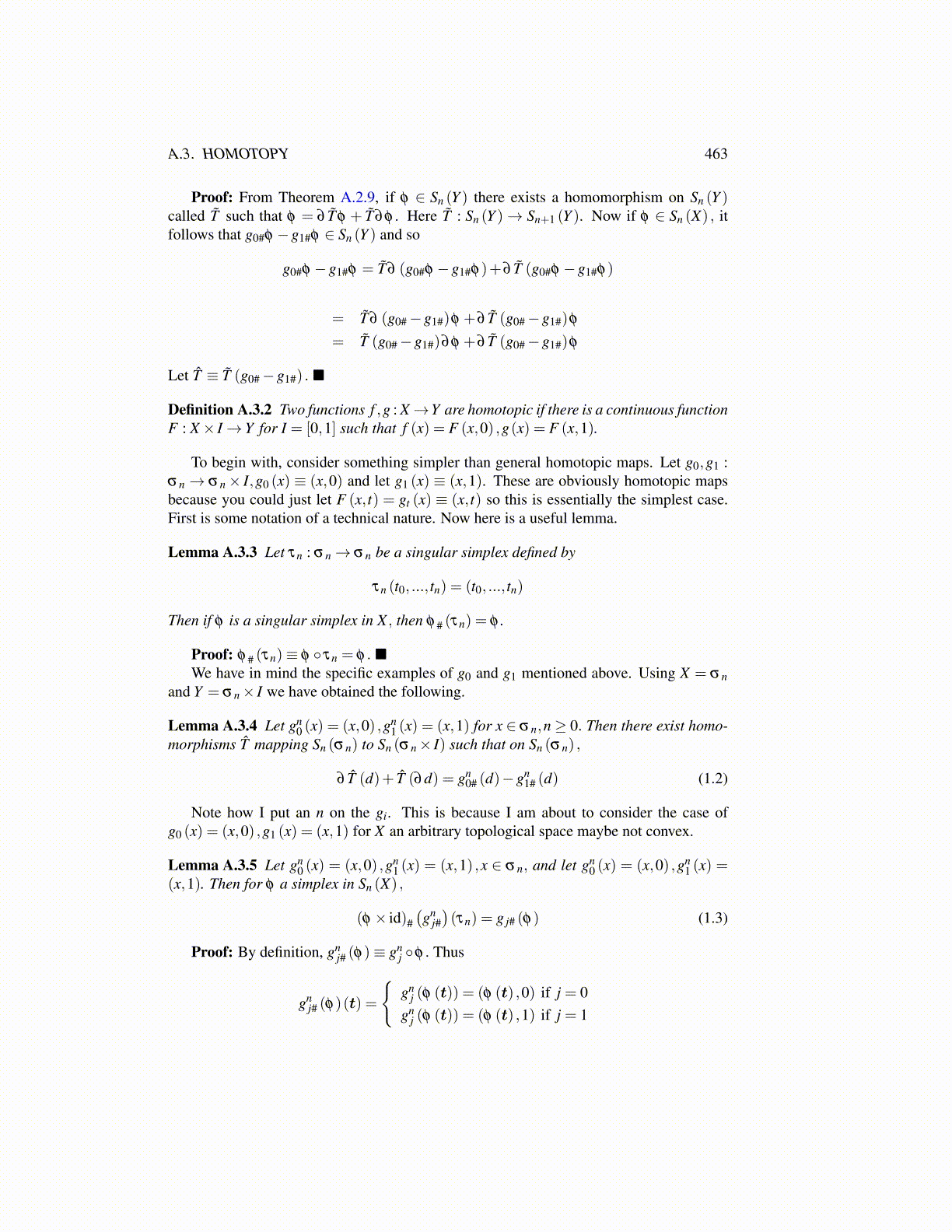
A.3. HOMOTOPY 463
Proof: From Theorem A.2.9, if φ ∈ Sn (Y ) there exists a homomorphism on Sn (Y )called T̃ such that φ = ∂ T̃ φ + T̃ ∂φ . Here T̃ : Sn (Y )→ Sn+1 (Y ). Now if φ ∈ Sn (X) , itfollows that g0#φ −g1#φ ∈ Sn (Y ) and so
g0#φ −g1#φ = T̃ ∂ (g0#φ −g1#φ)+∂ T̃ (g0#φ −g1#φ)
= T̃ ∂ (g0#−g1#)φ +∂ T̃ (g0#−g1#)φ
= T̃ (g0#−g1#)∂φ +∂ T̃ (g0#−g1#)φ
Let T̂ ≡ T̃ (g0#−g1#) . ■
Definition A.3.2 Two functions f ,g : X→Y are homotopic if there is a continuous functionF : X× I→ Y for I = [0,1] such that f (x) = F (x,0) ,g(x) = F (x,1).
To begin with, consider something simpler than general homotopic maps. Let g0,g1 :σn → σn× I,g0 (x) ≡ (x,0) and let g1 (x) ≡ (x,1). These are obviously homotopic mapsbecause you could just let F (x, t) = gt (x) ≡ (x, t) so this is essentially the simplest case.First is some notation of a technical nature. Now here is a useful lemma.
Lemma A.3.3 Let τn : σn→ σn be a singular simplex defined by
τn (t0, ..., tn) = (t0, ..., tn)
Then if φ is a singular simplex in X , then φ # (τn) = φ .
Proof: φ # (τn)≡ φ ◦ τn = φ . ■We have in mind the specific examples of g0 and g1 mentioned above. Using X = σn
and Y = σn× I we have obtained the following.
Lemma A.3.4 Let gn0 (x) = (x,0) ,gn
1 (x) = (x,1) for x ∈ σn,n≥ 0. Then there exist homo-morphisms T̂ mapping Sn (σn) to Sn (σn× I) such that on Sn (σn) ,
∂ T̂ (d)+ T̂ (∂d) = gn0# (d)−gn
1# (d) (1.2)
Note how I put an n on the gi. This is because I am about to consider the case ofg0 (x) = (x,0) ,g1 (x) = (x,1) for X an arbitrary topological space maybe not convex.
Lemma A.3.5 Let gn0 (x) = (x,0) ,gn
1 (x) = (x,1) ,x ∈ σn, and let gn0 (x) = (x,0) ,gn
1 (x) =(x,1). Then for φ a simplex in Sn (X) ,
(φ × id)#(gn
j#)(τn) = g j# (φ) (1.3)
Proof: By definition, gnj# (φ)≡ gn
j ◦φ . Thus
gnj# (φ)(t) =
{gn
j (φ (t)) = (φ (t) ,0) if j = 0gn
j (φ (t)) = (φ (t) ,1) if j = 1